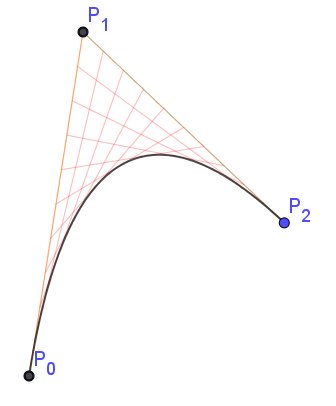Bézier Curves
Previously we have written the parametric line equation (where $A$ and $B$ represent points) as $L(t)=A+t(B-A)$. However, we could easily factor it differently. $$L(t)=(1-t)A+tB \tag{1} \label{1}$$
Now suppose that we wanted to take the two new points, $(x_{0},y_{0})$ and $(x_{1},y_{y})$ and connect them too with a linear interpolation equation. That equation would be
$$\left(\begin{array}{c}
x_{2}\\
y_{2}
\end{array}\right)=(1-t)\left(\begin{array}{c}
x_{0}\\
y_{0}
\end{array}\right)+t\left(\begin{array}{c}
x_{1}\\
y_{1}
\end{array}\right). \tag{5} \label{5}$$
If we did that at $t=0,.1,.2,.3\ldots,1$ we would get string art.
What we will do next is to re-write equation $\bbox[darkblue]{\eqref{3}}$ and substitute for $P_{0}$ and $P_{2}$ the two equations of $\bbox[darkblue]{\eqref{4}}$. Essentially, we will be doing a linear interpolation between a linear interpolation.
$$L(t)=\left(\begin{array}{c}
x\\
y
\end{array}\right)=(1-t){\color{green}\left[(1-t)P_{0}+tP_{1}\right]}+t{\color{blue}\left[(1-t)P_{1}+tP_{2}\right]}\qquad 0\le t\le1\tag{6} \label{6}$$
Equation $\bbox[darkblue]{\eqref{6}}$ now graphs as the black curve in figure 3. Although only marginally better, the equation simplifies to
$$L(t)=\left(\begin{array}{c}
x\\
y
\end{array}\right)=(1-t)^{2}P_{0}+2(1-t)\cdot t\cdot P_{1}+t^{2}P_{2} \tag{7} \label{7}$$

Following the form of equation $\bbox[darkblue]{\eqref{7}}$ we can extend the number of interim points indefinitely. The next one is called a cubic Bèzier and is written as
$$(1-t)^{3}P_{0}+3(1-t)^{2}tP_{1}+3(1-t)t^{2}P_{2}+t^{3}P_{3}. \tag{8} \label{8}$$
When $t$ is zero, the curve will be at $P_0$ and when $t=1$ the curve will be at $P_3$. Any other values of $t$ between $0$ and $1$ will cause the curve to be influenced by $P_1$ and $P_2$.